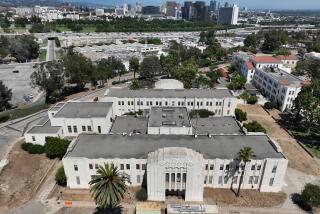Young Campus Breaks Ground for Retail-Residential Project
- Share via
University senior Alan Howard looks forward to the day he no longer has to rely on a catering truck for daily sustenance at the budding Cal State Channel Islands campus.
That day should come soon. The Ventura County campus broke ground Monday on a 30,000-square-foot, mixed-use town square that will house a restaurant, convenience store and other amenities typically found at established universities.
Officials are hoping the three-story Town Center, scheduled to open in 15 months, will generate enough revenue to help finance the campus’ expansion plans, which are being squeezed by an enrollment cap imposed on all 23 Cal State campuses because of the state budget crisis.
On Monday, university officials called the residential-commercial space a step on the fledgling university’s road to maturity.
“It’s another significant milestone for this young campus,” university President Richard Rush told a crowd gathered under wind-swept skies for a groundbreaking ceremony. “Students and their needs are always at the center of our efforts.
“With residence halls and retail and commercial space to serve our community, the Town Center will also serve as a revenue stream to restore our beautiful campus into a first-rate educational institution for current and future students.”
Responsible for converting a shuttered mental hospital into a modern college, university officials set out more than six years ago to create a range of business ventures designed to generate cash to complete the work. The Cal State governing board said in 1998 that the new university would have to generate its own capital to renovate the property.
The $13-million Town Center project, which will be financed by bonds, is steps away from the newly opened University Glen residential complex, a subdivision built to attract faculty and staff by offering housing at a discount. Cal State Channel Islands has about 350 full-time employees.
Residential units in both the town square and University Glen are expected to generate more than $800 million over the next 50 years, money that will be used to repay bonds issued to finance construction of academic facilities.
But Howard, a pharmaceuticals development major, was less concerned with the financial details than the gastronomic and social possibilities the center promises. The Camarillo resident pointed out that there is no place for the campus’ 1,627 full-time students to meet, socialize or dine.
“We have to eat at a roach coach,” said Howard, referring to a lunch truck that parks on campus every day.
Out of desperation, Howard has even ordered pizza delivered to the bell tower, a well-known campus landmark.
“But then you look kind of weird, walking around with a box of pizza,” he said.
Howard and other students said they would like to see a restaurant, a cafe, an office supply store and a bar in the complex.
The Town Center will be behind the future John Spoor Broome Library, named for a major benefactor of the campus. It will consist of four three-story buildings set around a central courtyard. Retail and office space will occupy the first floor, and the second and third floors will be devoted to residential units.
The campus bookstore, a copying center and other food outlets are planned for the site, along with the restaurant and convenience store, said Caroline Doll, real estate manager for University Glen.
There are no plans for a pub or tavern because marketing surveys indicate the campus population is too small to support one, she said.
Some students expressed concern that the town square was being built on student parking land, but Doll said another parking lot was being built across campus to compensate for the lost spaces.
More to Read
Sign up for Essential California
The most important California stories and recommendations in your inbox every morning.
You may occasionally receive promotional content from the Los Angeles Times.













